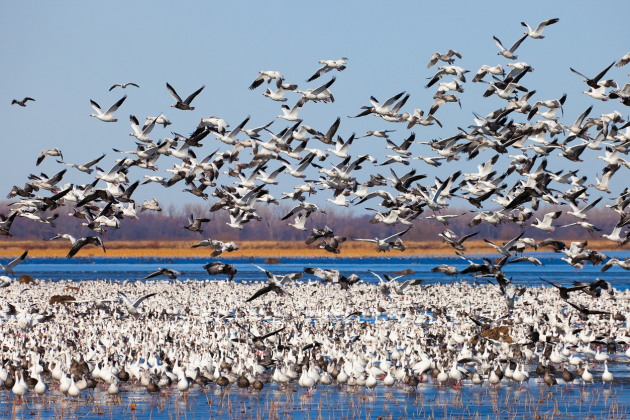There’s certainly no shortage of snow geese in North America, but to see 10,000 birds die in a single stroke from pollution is still a tragedy. Such is the case in Butte, Montana, where a flock of the migratory birds tried to land on water in the bottom of the Berkeley Pit. While the vast majority of the birds died outright, a handful of snows survived a few days before finally succumbing to the exposure.
The Berkeley Pit is a former open-pit copper mine measuring one mile long by half a mile wide. It’s more than 1,700 feet deep, with a pool of water measuring roughly 900 feet deep at its bottom. It was this 700-acre lake that thousands of snow geese tried to land on November 28, with deadly effect. The final tally is underway, but officials estimate as many as 10,000 geese died when exposed to the pit’s heavily polluted water.
The mine’s water has been measured at an acidity of 2.5 pH, roughly the equivalent of a soft drink or lemon juice. Pure water is neutral on the pH scale of 0-14, with healthy freshwater at 7 pH. Add to the acidity of the water the presence of heavy metals and the lake becomes a death trap for anything swimming in or on it.
Mark Thompson, manager of environmental affairs for mine operator Montana Resources, was quoted by the Montana Standard as saying the lake was “white with birds” after the catastrophe.
A few geese survived long enough to fly away from the mine. Two bodies were found in a Walmart parking lot; another bird was found alive on a city street but died soon after. Some 50 snows survived initial contact with the Berkeley Pit’s water and were alive Monday, but they were reportedly dead by the following day.
Any birds that are found alive will be treated by veterinarians and “flushed out” to rid them of the polluted water. The EPA will reportedly pay for the vet costs, but as of now it looks like the bill will be a small one.
The Berkeley Pit has been defunct as of Earth Day (April 22), 1982. Tourists can visit the mine, paying $2 to enter and view the area from overlook platforms. While the mine has lain quiet for more than three decades, its effects on the environment continue. Listed as a federal Superfund site, the Berkeley Pit was the scene of an earlier snow goose die-off, although on a much smaller scale; 342 carcasses were recovered in 1995 after another flock landed on the water.

